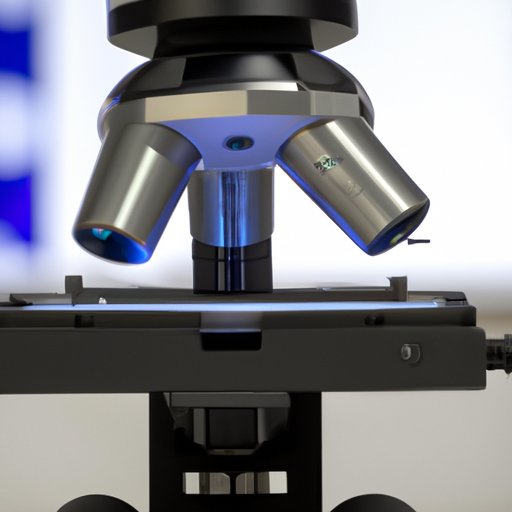Introduction
A light microscope is a powerful tool used in scientific research to study objects that are too small to be seen by the naked eye. It utilizes visible light and lenses to magnify objects so they can be studied in detail. This article provides an overview of how a light microscope works, exploring its components, functionality, and the magnification power it offers.
Step-by-Step Guide to Understanding How a Light Microscope Works
To understand how a light microscope works, it’s important to first familiarize yourself with its components and the function each one serves. A light microscope generally consists of an illumination source, magnification power, objectives and eyepieces.

Exploring the Components of a Light Microscope
Objectives are the lenses at the bottom of the microscope that gather light from the specimen being studied. They are usually labeled with their magnification power, such as 4x, 10x, or 40x. The eyepieces are located at the top of the microscope and serve to magnify the image further. The stage is the platform on which the specimen is placed, while the condenser helps focus the light onto the specimen.
The illumination source is located underneath the stage and helps provide a bright light source for viewing the specimen. This can be a light bulb, LED, or fluorescent lamp.

Illuminating the Functionality of a Light Microscope
Light microscopes work by collecting light from the specimen, focusing it into an image, and then adjusting the magnification to view the object in greater detail. When light enters the objective lens, it passes through the specimen and is then focused into an image on the stage. The eyepiece then magnifies this image for a clearer view.

What You Need to Know About Operating a Light Microscope
Before you can use a light microscope, you must prepare the specimen. This involves cutting, staining, and mounting the specimen on a slide. Once the specimen has been prepared, you can begin using the microscope correctly. This includes adjusting the focus and adjusting the magnification as needed. Finally, it’s important to keep your microscope clean and well-maintained to ensure it continues to perform optimally.
Discovering the Magnification Power of a Light Microscope
Light microscopes have a limited magnification power, usually ranging from 40x to 1000x. The total magnification of an image is calculated by multiplying the magnification of the objective lens by the magnification of the eyepiece. For example, if the objective lens is 10x and the eyepiece is 10x, the total magnification would be 100x.
An Overview of How a Light Microscope Enhances Scientific Research
Light microscopes are invaluable tools for scientific research, allowing researchers to observe details that would otherwise go unnoticed. With the help of a light microscope, researchers can examine specimens, analyze data, and make observations that wouldn’t be possible without its magnification power.
Conclusion
A light microscope is a powerful tool used in scientific research to examine specimens in greater detail. This article has provided an overview of how a light microscope works, exploring its components, functionality, and the magnification power it offers. By understanding the components and functionality of a light microscope, researchers can use it to its fullest potential, unlocking new possibilities for scientific research.
(Note: Is this article not meeting your expectations? Do you have knowledge or insights to share? Unlock new opportunities and expand your reach by joining our authors team. Click Registration to join us and share your expertise with our readers.)
